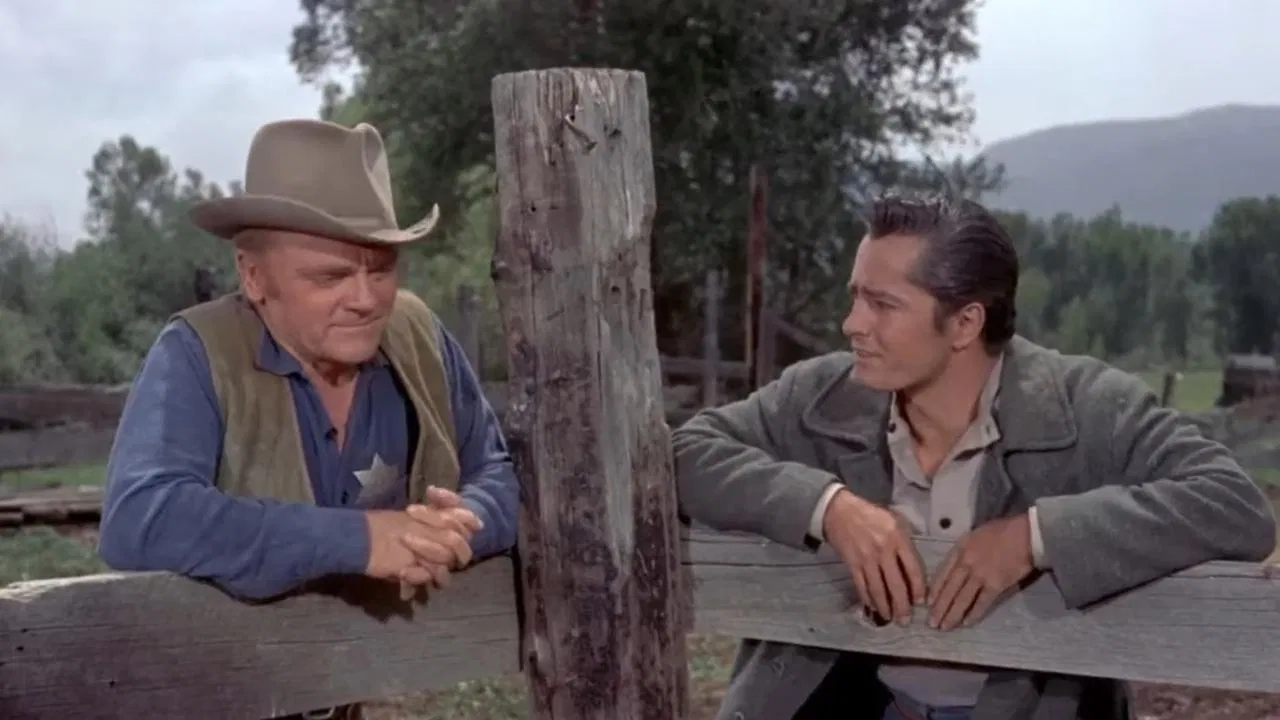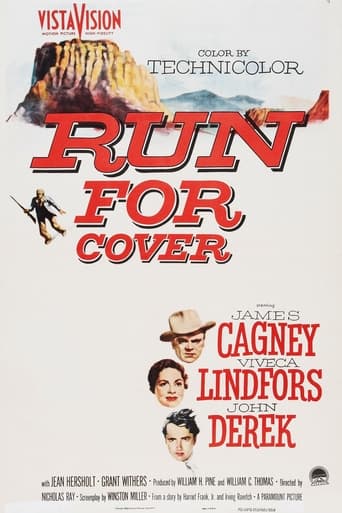

Very disappointed :(
... View MorePlease don't spend money on this.
... View MoreExcellent, smart action film.
... View MoreGreat example of an old-fashioned, pure-at-heart escapist event movie that doesn't pretend to be anything that it's not and has boat loads of fun being its own ludicrous self.
... View MoreThis interesting western was shot mainly around Durango, CO, and the Aztec ruins in NM., as well as some studio shots, all in Technicolor. I enjoyed it despite a few questionable aspects........ Clearly, the heart of the drama is the complex and fluctuating relationship between James Cagney's and John Derek's characters. It starts out something like the relationship between mature ex-sheriff Henry Fonda and young new sheriff Anthony Perkins, in "The Tin Star", where Fonda gives Perkins advice on how to be an effective sheriff and gunslinger. In the present case, the mature Cagney gives a reluctant young Derek a chance to prove himself as a sheriff's deputy. But, in this case, it doesn't work out well, as Derek loses a prisoner(played by Ernest Borgnine) he is escorting to another town. Derek quits in embarrassment.. He then, unknowingly, joins a band of thieves, who rob the town bank in broad daylight, while practically the whole town is in church. The gang would soon meet an ignominious end, without involvement of the sheriff or town's people........Let me say that, when Cagney and Derek first met, out in the boondocks , Cagney very nearly pugged Derek, who came upon him quite by surprise. This was just the first of a series of incidents where it was the intent of one to defend or to shoot or otherwise promote the death of the other. While on the trail of the bank robbers, Derek suddenly, pulled out his gun and was about to fire at Cagney, when his horse reared up. This is when Cagney discovered that he was allied with the robbers(In what capacity, isn't apparent). For a while, they rode together in an uneasy truce. But when, they have to swim a raging river, Cagney calls out for help, but Derek ignores him. Derek gets to the far shore first, and heads for the Aztec ruins, where he finds Borgnine: the prisoner who escaped from him(Why did he come to this forsaken place?). They have an uneasy truce. WARNING: SPOILER ALERT! Cagney survives the rapids and later encounters these ruins, eventually finding the other 2. Initially, there is an uneasy truce. But, Borgnine draws on Cagney, who shoots him apparently dead. The remaining 2 have some words. Borgnine is not quite dead, and slowly reaches for his gun on the floor. Cagney doesn't see this, but Derek finally does, as Borgnine is about to shoot Cagney. Derek draws his gun and fires at Borgnine, while Cagney shoots Derek, whom he assumed drew to kill him: Only one lucky survivor, and he knows where the bank money is hidden........Viveca Lindfors, as Helga Swenson, who emigrated from Sweden with her father, takes a liking to Cagney, seeing his devotion to his friend Derek, who had serious gunshot wounds instilled by a posse that assumed that he, along with Cagney, were a pair of train robbers. Derek is staying with the Swensons during recovery. Pretty soon, Cagney and Helga are talking marriage. Cagney says he wants to live in their house. But, this may sometimes cause conflict with Mr. Swensen. Conveniently, the latter is formalistically killed in the bank raid, thus eliminating this potential problem. This principle is applied in many westerns, where the traditional significant other of a person is eliminated to symbolically clear the way for a new significant other.
... View MoreRun for Cover (1955)The first reason to see this is the simple fact it's a Nicholas Ray movie. Ray didn't direct many movies, but among those few are some of the best--or at least my favorites--in the whole history of Hollywood. "They Live by Night" and "In a Lonely Place" are moving and interesting masterpieces, and "Johnny Guitar" is completely bizarre and original and a wild ride. Only slightly less interesting to me but more iconic is "Rebel without a Cause," made the same year as this one."Run for Cover" is an awkward fit, a Western by a director of mostly urban dramas. James Cagney isn't really cast wrong, per se, because he's presented as an outsider in this typical rough frontier town, but he comes off a little superficial, using his razor fast approach as an end rather than a means. And I think this is because the story is weak. It sounds good on paper, but it unfolds a little obviously, with some filler and some seemingly requisite but boring views of beautiful landscapes. There are gunfights, a run-in with Indians, and deception. It's a story without emotional subtlety and Ray is best a peeling back layers in human interaction, not just showing the action.Even the interesting Viveca Lindfors (who originally led me to the movie after seeing her in "Backfire," is oddly stiff, doubly odd because she's a Swedish immigrant playing a Swedish immigrant. You get the feeling she was never a poor farmer back home.I don't mean to pile on criticisms, but it's worth saying that the direction isn't good, either. The filming is dull, there are a couple of odd moments like when a big log suddenly appears in the river to save someone, and sometimes the cuts don't match one to the next. I'm guessing there's a deeper story to the awkwardness here, but all we have is the awkwardness.Not that it's a disaster. I watched the whole thing, and the key theme of being honorable even when being misunderstood is good. And a really nasty deception (or plain old ingratitude) is pulled off right before our eyes, more than once.. The filming location seems to be Colorado rather than California or Arizona (as many Westerns are), and that gives it a different feel. And there is a short section (out of nowhere) shot in an ancient Indian ruin in New Mexico, with good atmospherics. Plug your ears to some of the overdone music, and let the plot ride off a little on its own and there's a good chance you'll like a lot of this movie.
... View More"Run for cover" occupies a curious place in Nicholas Ray's brilliant filmography.Sandwiched between "Johnny Guitar" and "Rebel without a cause,it suffered accordingly.They say Ray himself disliked it.And however,in "Run for cover" he opened up as he never did before.In "knock on any door" ,Ray had already displayed a "father" -"son" relationship between Bogart and John Derek (who takes on here roughly the same kind of part he played at the beginning of the fifties).Ray would reach his peak with the following work ("Rebel" ) where Plato wanted Jim to be his dad and began to think of a new family with his pal and Judy.Davey is a tragic character .He seems to be born under a bad sign ,he is known to have a very bad reputation wherever he goes.It's obvious in the scene of the train:whereas Matt (Cagney) wants to give the money back to the town,Davey is thinking of the life he could lead if this loot were his.Matt knows that Davey needs someone to become a man .Alone he would walk on crutches .His leg is a transparent metaphor.Maybe he thinks of a new family he would rebuild with Helga (Viceca Lindfords).The relationship between the mature man and the Swede is full of tenderness and human warmth,a permanent feature in Ray's canon (see the lovers of "they live by night" and the teenagers in " Rebel without a cause".Like Jeff in "lusty man",Matt had a raw deal and he wants to make the best of the years which he's still got to live.Jeff will help Wes become a man in the cruel world of rodeo,but it's a different matter with Davey Bishop (what a surname!).It's remarkable that violence appears twice after scenes depicting children: the first time when Matt is making a wooden gun for a boy ;the second time in the church as a choir of little boys and girls is singing a canticle to praise the Lord."Rebel without a cause" is probably Ray's most underrated work.Davey remains his most moving character ;without any mawkishness ,the director paints the picture of the rebel with a cause,who cannot understand why he should work for eight dollars a week when there's plenty of money to take.The last line is my favorite in any Ray movie.In its own special way,it preserves the viewer from despair.
... View MoreNicholas Ray will be remembered for "The Lusty Men," "Johnny Guitar," "Run for Cover," and "The True Story of Jesse James."With a slight echo of "High Noon," the film is Cagney's first Western, shot in stunning Technicolor and VistaVision, since Lloyd Bacon's "Oklahoma Kid" in 1939... Cagney was beginning to show his age, but his performance is colorful as always... It is interesting to remark that Grant Withers whom Cagney had supported in his film debut ("Sinner's Holiday," 1930) and his third movie ("Other Men's Women", 1931) is in his support as Gentry....Released from a six-year prison term for a crime he did not commit, Cagney goes West, where he meets John Derek...Riding along, they innocently become involved in a train robbery and are later ambushed by a posse... Derek's leg is smashed and is taken to Viveca Lindfors' farm where she nurses him and falls in love with Cagney...The townsfolk offer Cagney the tin star, and he appoints Derek (who is now a cripple), as his deputy...Derek's bitterness over his bad accident separates the two men in different directions and soon are seen on opposite side in a fight involving Grant Withers' widely known gang and a group of Indians...
... View More